
views
X
Research source
- Cut 4–6 inches (10–15 cm) of the inch plant’s stem and place it in water to propagate the plant.
- If you want to place the cutting in soil, put a plastic bag over the top of the plant and wait for expansive growth.
- Keep your inch plant in a bright area with plenty of indirect light and water it whenever the soil dries out entirely.
Cutting

Clean some sharp scissors or pruning shares. Inch plant is exceptionally easy to cut—the stems aren’t particularly rugged or hard. Still, you don’t want diseases infecting your plant. Clean the scissors or small pruning shears you plan on using with isopropyl alcohol or general disinfectant.
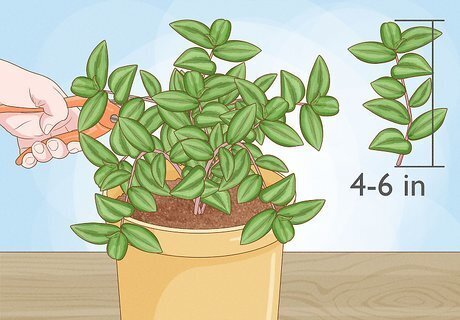
Cut 4–6 inches (10–15 cm) of the plant’s stem just below a node. The nodes are the small bumps on the plant’s stem where new leaves develop. Cut a length of inch plant a fraction of an inch below any node at a 45-degree angle to remove your cutting. If you want to propagate multiple cuttings, repeat this process as many times as you’d like. You can propagate multiple cuttings in the same container if you’re placing them in soil. If you’re using pots of water, get a separate container for each cutting. Leaving a node at the bottom will give the plant a place to develop roots. If you cut through or over a node, your plant won’t develop. Fun fact, the name “inch plant” comes from the nodes appearing every 1 in (2.5 cm) on the stem.
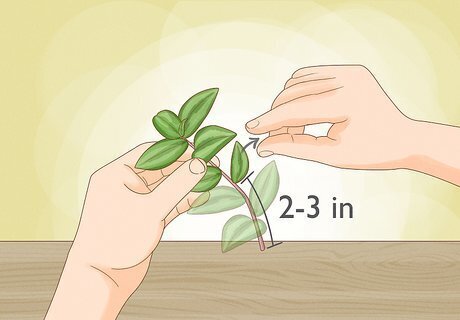
Remove the lowest set of leaves from the cutting, if necessary. The bottom 2–3 inches (5.1–7.6 cm) of the cutting need to be leaf-free, so pluck off any extra leaves at the bottom of the cutting. Simply pinch the base of each leaf with your fingers and pull them off.
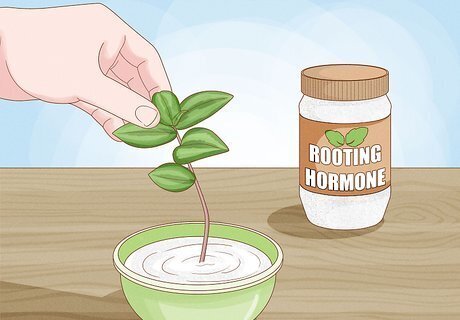
Dip the bottom of the cutting in rooting hormone (optional). Rooting hormone is a commercial product designed to accelerate growth when you take a cutting. If you want to speed this process up, dip the bottom third of each cutting in the rooting hormone. Inch plant grows like crazy, so this is totally optional. Don’t worry if you skip the rooting hormone.
Propagating in Water

Fill a small drinking glass or pot ¾ of the way with lukewarm water. Any kind of clean glass will work for this. If you’ve got a pot designed for plants, feel free to use that. You can also use a regular old drinking glass if you’d like. Fill the container with tepid tap water. Most plant enthusiasts think it’s easiest to propagate inch plant in water. Both water and soil will work, though!

Put the cutting in the water and set the plant in a bright area. Set your cutting in the water with the exposed stem fully submerged. Angle the leaves out of the container so they don’t fall into the water. Set the plant in a bright room that’ll stay 60–80 °F (16–27 °C), but don’t put the plant right against the window. Inch plants thrive best in indirect light. Inch plant is really not difficult to care for at this stage. Just leave the plant alone and it’ll begin to thrive!
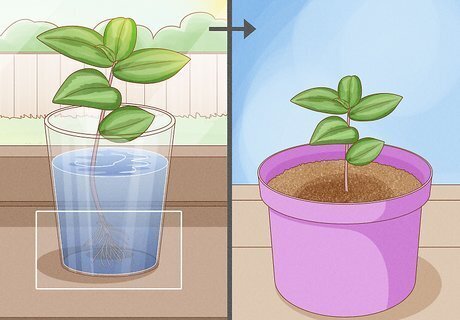
Transfer the plant to a pot of soil after roots have developed. You can tell roots are coming in once a bulb develops in the water and tiny shoots begin to grow. The water may even turn a little murky, and the colorful leaves will be vibrant and bigger than they were once you set the cutting in water. You can also leave the inch plant in the water. It’ll continue to grow and thrive in water—it just won’t grow as thick and bushy as it will in soil.
Propagating in Soil

Fill a small pot ¾ of the way with moist potting mix. Grab a small pot; 4–12 inches (10–30 cm) in diameter will work depending on how big you want the plant to grow. Fill it ¾ of the way with a general potting soil mix. Sprinkle in some water and mix the soil up in the pot. Inch plant is not a tepid grower. It’ll fill whatever pot you put it in and then some. If you want a giant plant, put it in a bigger pot! You can propagate multiple cuttings in a single pot if you’d like.
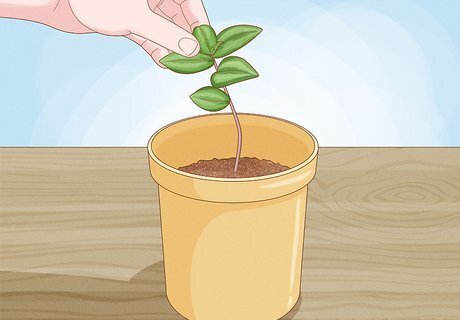
Stick the cutting in the middle of the pot. Stick the leafless bottom third of the cutting into the soil with the leaves sticking out above. If the leaves droop, let them rest on the top of the circle. If the top portion of the leaves stick up in the air, that’s fine, too. If you’re propagating multiple cuttings, space them out evenly around the middle of the pot.

Cover the pot with a plastic bag and rubber band for about 1 month. Grab a big, clear bag and slide it upside-down on top of the pot. Spread a rubber band around the pot to secure the bag tightly to the container. This will lock the moisture from the soil in and keep your cutting moist.
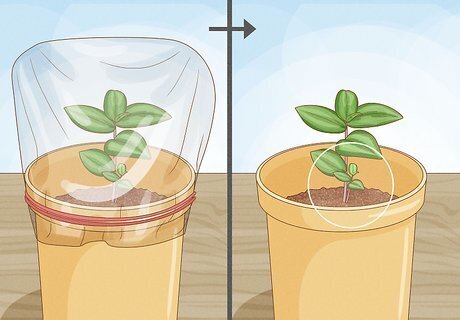
Remove the plastic when new growth has occurred. It should take around a month for your inch plant to basically explode in growth. You may see multiple fresh shoots develop, or your single cutting may start to branch off and expand. This expansive growth is a sign the plant is fully rooted and ready to thrive. Take the plastic bag off and remove the rubber band.
After Rooting
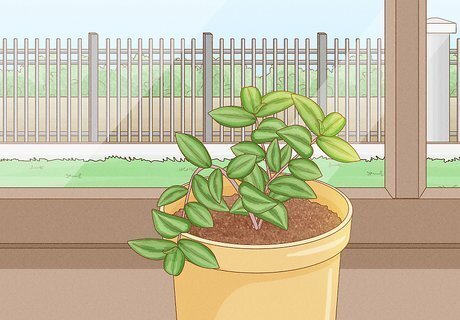
Place the plant in an area that gets bright, indirect light. Inch plant is a very easy plant to keep happy. It requires plenty of light, but it prefers indirect light. This makes it a perfect plant for mantles, end tables, or TV stands that are adjacent to windows. So long as the area lights up during the day, your plant will thrive. You can 100% place the plant outside so long as it doesn’t get lower than 60 °F (16 °C) at night, but bring the pot inside during the winter months.

Make sure the room the inch plant is in stays 60–80 °F (16–27 °C). Inch plants are native to Mexico, so they prefer warmer climates. Luckily, most people keep their home around 70 °F (21 °C) anyway. So long as you maintain a stable temperature around the clock, your inch plant will do just fine. This is partly why inch plants are such popular options for new plant enthusiasts who aren’t comfortable tackling plants with tougher care regimens. When it comes to temperature and sunlight, your inch plant wants all of the same things you do!

Keep the soil moist at all times and water as needed. Most people end up watering their plant once every other week or so. Put your finger in the top 1 in (2.5 cm) of the soil. So long as it’s moist, you don’t need to water your plant. Whenever the soil dries out entirely, water lightly. If you’re keeping the inch plant in water, just replace the water every few weeks or whenever the water gets dirty.

Look for consistent growth and a uniform color. A lot of plants won’t let you know when they’re unhappy with the care you’re providing, but not the inch plant! If the leaves stay colorful and rigid, and the stems continue to grow, you’re providing adequate care. If the leaves start losing color, it’s a sign that you’re either watering too often or not often enough. The inch plant will shed dead leaves periodically whenever it experiences new growth. Don’t worry—this is totally normal. Inch plants tend to droop and hang when they grow larger. If you want a bushier plant, trim back the excess growth periodically to keep the plant smaller. It’ll thicken up and grow like a shrub. Now all you have to do, is continue caring for your plant!















Comments
0 comment